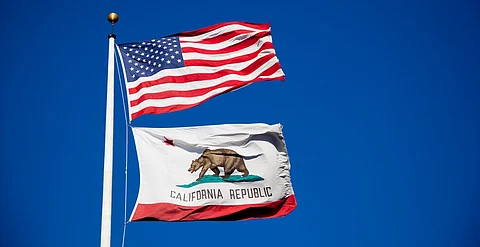

California, the richest state in the United States of America, is currently in the news for the wildfires that have been raging in Los Angeles, the second-largest city in the US.
California has been a symbol of the ‘American Dream’ with its varied vistas including sun-kissed beaches, the snow-capped Sierra Nevada, Silicon Valley, Napa Valley and San Francisco’s Golden Gate Bridge.
But not everyone has been an equal stakeholder in California’s dazzling success. The state’s indigenous people had to pay a heavy price as Euro-American settlers colonised the land. And then, there is the state animal, which is no longer around: The California grizzly bear (Ursus arctos californicus).
Once abundant in the state, this subspecies of brown bear is today extinct, a testament to humanity’s cruelty and viciousness towards non-human species.
The animal is most famously known through the ‘Bear Flag’.
“The California State Flag, also known unofficially as the “Bear Flag,” is the oldest unofficial State Symbol. Though it came into existence during the short-lived Bear Flag Revolt in the spring of 1846, it was not officially adopted as California’s official State Flag until 1911. Its full design and color scheme were not settled upon by the Legislature until 1953,” according to the website of the State of California Capitol Museum.
The California grizzly is also the state animal of California. “California’s State Animal is the California grizzly bear. As the state’s largest and fiercest predator, the grizzly had California to itself for hundreds of thousands of years,” notes the State of California Capitol Museum.
But why did the bear go extinct?
The first European to reach and explore the coast of California was the Portuguese explorer Juan Rodriguez Cabrilo, who served the Spanish Crown.
From the very start, European settlers had an acrimonious relationship with the California bears. “Historical documents portrayed California grizzlies as massive hypercarnivores that endangered public safety,” a paper published in 2024 titled Coupled social and ecological change drove the historical extinction of the California grizzly bear (Ursus arctos californicus) notes.
The authors of the paper however add that, “…morphological measurements on skulls and teeth generate smaller body size estimates in alignment with extant North American grizzly populations (approximately 200 kg)”.
Even more importantly, the researchers of the paper showed that the bears of California were not the gigantic meat-eating machines as they were portrayed to be.
“Stable isotope analysis (δ13C, δ15N) of pelts and bones (n = 57) revealed that grizzlies derived less than 10% of their nutrition from terrestrial animal sources and were therefore largely herbivorous for millennia prior to the first European arrival in this region in 1542,” they write.
In the mid-1700s, there were land use changes in California.
While the bears increased their animal protein intake, most of their diet was still herbivorous, say the researchers: “Following European contact in 1542, and especially after the onset of the Spanish Mission era in 1769, California grizzlies roughly doubled their consumption of terrestrial animal protein, including some livestock, but continued to derive most of their nutrition from plants.”
Spanish-speaking settlers established a chain of missions from San Diego to Sonoma, with cattle herds that grew from 300 head in 1778 to at least 400 000 head by 1821.
“By 1846, California’s ranchos were producing thousands of cow hides and other livestock products. Carcasses abandoned on the range and in outdoor abattoirs attracted grizzlies, but Spanish and Mexican ranchers largely tolerated them, only capturing grizzlies for bear and bull fights or dispatching those that presented a clear threat,” the authors write.
All this would soon come to an end. Anglo-American settlers started moving into California in huge numbers with the discovery of gold in John Sutter’s mill in 1848. The era of the California Gold Rush (1848-1855) was finally here.
“In California, Anglo-American settlers hunted, poisoned and trapped grizzlies in response to descriptions such as one Kern County account alleging that a grizzly had killed a flock of two hundred sheep. This animosity sparked a campaign of persecution that was eventually written into a state law (Stats. 1876, chap 3s1) which provided a bounty for grizzlies killed in certain counties,” the paper notes.
“The loss of habitat and over-hunting by a rapidly growing human population led to their complete extinction by the 1920s,” the State of California Capitol Museum website adds.
The last California grizzly was credibly sighted in 1924 on the western slope of Sequoia National Park in the southern Sierra Nevada.
California is the only US state that carries the image of an extinct animal on its state flag and seal. While there is talk of rewilding California with grizzlies, the authors of a 2021 paper note that, “Engineering a systematic, fair, and inclusive policy-deliberation process concerning the California Grizzly will be a uniquely challenging task.”
For now, though, California is without its state emblem and its forests have been bereft of their apex predator for over a century.